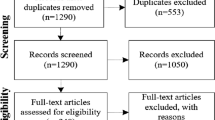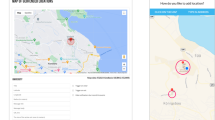Abstract
Mobile professionals require access to documents and document‐related services, such as printing, wherever they may be. They may also wish to give documents to colleagues electronically, as easily as with paper, face‐to‐face, and with similar security characteristics. The Satchel system provides such capabilities in the form of a mobile browser, implemented on a device that professional people would be likely to carry anyway, such as a pager or mobile phone. Printing may be performed on any Satchel‐enabled printer, or any fax machine. Scanning, too, may be accomplished at any Satchel‐enabled scanner. Access rights to individual documents may be safely distributed, without regard to document formats. Access to document services is greatly simplified by the use of context sensitivity. The system has been extensively tested and evaluated. This paper describes the architecture of the Satchel system.
Similar content being viewed by others
References
A. Baggio and I. Piumarta, Mobile host tracking and resource discovery, in: Proc. of the 7th ACM SIGOPS European Workshop, Connemara, Ireland (1996).
T. Berners-Lee and D. Connolly, Hypertext Mark-up Language-2.0. RFC 1866 (November 1995).
T. Berners-Lee, R. Fielding and H. Frystyk, Hypertext Transfer Protocol-HTTP/1.0. RFC 1945 (May 1996).
T. Berners-Lee, L. Masinter and M. McCahill, Uniform Resource Locators (URL), RFC 1738 (December 1994).
Bluetooth technology overview, 1998.
N. Borenstein and N. Freed, MIME (Multipurpose Internet Mail Extensions), Part 1: Mechanisms for specifying and describing the format of Internet message bodies, RFC 1521 (1993).
CGI: Common Gateway Interface. NCSA Software Development Group.
T. Dierks and C. Allen, The TLS Protocol, RFC 2246 (January 1999).
C. Donnelly and R. Stallman, The Bison Manual: Using the YACC-compatible Parser Generator, Free Software Foundation; ISBN: 1882114450 (1995).
A. Fox, I. Goldberg, S.D. Gribble, D.C. Lee, A. Polito and E.A. Brewer, Experience with Top Gun Wingman: A proxy-based graphical Web browser for the 3Com PalmPilot, in: Proc. of Middleware '98, Lake District, England (September 1998).
J. Franks, P. Hallam-Baker, J. Hostetler, P. Leach, A. Luotonen, E. Sink and L. Stewart, An extension to HTTP: Digest access authentication, RFC 2069 (January 1997).
A. Frier, P. Karlton and P. Kocher, The SSL 3.0 Protocol, Netscape Communications Corp. (November 1996).
Handheld Device Markup Language specification, Unwired Planet, Inc., Redwood City, CA (1997).
IrDA: Infra Red Data Association, Walnut Creek, California (1997).
R. Khare, W* effect considered harmful, IEEE Internet Computing 3(4) (July/August 1999) 89–92.
M. Lamming, M. Eldridge M. Flynn, C. Jones and D. Pendlebury, Satchel-providing access to any document, any time, anywhere, Transactions on Computer-Human Interaction, in press.
M.G. Lamming and M. Flynn, “Forget-me-Not”: Intimate computing in support of human memory, in: FRIEND21 Symposium on Next Generation Human Interface, Tokyo, Japan (February 1994).
J. McKeehan and N. Rhodes, Programming for the Newton, AP Professional, ISBN: 012484832X (1996).
S. Putz, Design and implementation of the System 33 document service, Xerox Palo Alto Research Centre P93-00112 (1993).
A. Ramanujapuram and P. Ram, Digital content and intellectual property rights, Dr. Dobb's Journal (December 1998).
Research In Motion introduces wireless e-mail solution for Microsoft Exchange users, Press Release, Research In Motion Limited, Waterloo, ON, Canada (1999).
A. Salomaa, Public-Key Cryptography (Springer, Berlin/Heidelberg, ISBN: 3540613560, 1996).
C. Tait, H. Lei, S. Acharya and H. Chang, Intelligent file hoarding for mobile computing, in: Proc. of the 1st ACM Conf. on Mobile Computing and Networking, Mobicom 95, Berkeley (1995) pp. 119-125.
D.B. Terry, K. Petersen, M.J. Spreitzer and M.M. Theimer, The case for non-transparent replication: Examples from Bayou, IEEE Data Engineering (December 1998) 12-20.
Universal Plug and Play initiative announcement, Press Release, Microsoft, Redmond, WA (1999).
J. Waldo, Jini architectural overview, Sun Microsystems, Palo Alto, CA (1999).
R. Want, W.N. Schilit, N.I. Adams, R. Gold, K. Petersen, D. Goldberg, J.R. Ellis and M. Weiser, An overview of the PARCTAB ubiquitous computing environment, IEEE Personal Communications 2(6) (December 1995) 28–43.
C. Weider and J. Reynolds, Executive introduction to directory services using the X.500 protocol, FYI 13, RFC 1308, ANS, ISI.
M. Weiser, The computer for the twenty-first century, Scientific American (September 1991) 94-100.
Wireless Application Protocol architecture specification, Wireless Application Protocol Forum Ltd. (April 1998).
WML: Wireless Markup Language, Wireless Application Protocol Forum Ltd. (April 1998).
Author information
Authors and Affiliations
Rights and permissions
About this article
Cite this article
Flynn, M., Pendlebury, D., Jones, C. et al. The Satchel system architecture: Mobile access to documents and services. Mobile Networks and Applications 5, 243–258 (2000). https://doi.org/10.1023/A:1019172931873
Issue Date:
DOI: https://doi.org/10.1023/A:1019172931873




